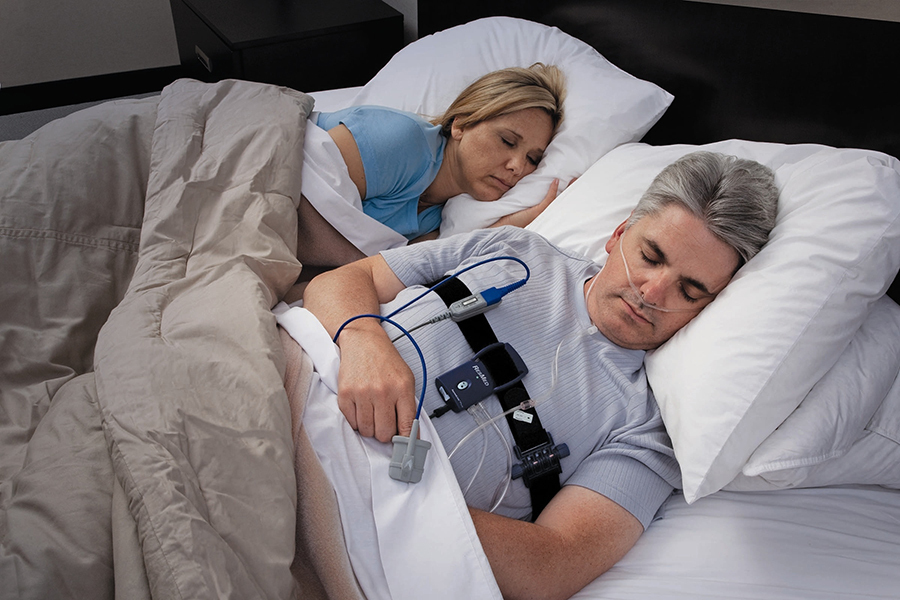Exactly How a Sleep Research Can Change Your Sleep Patterns: Insights and Services Available
A rest study serves as a necessary device for individuals seeking to recognize and enhance their rest patterns. It provides a detailed analysis of sleep habits and prospective conditions. By reviewing numerous metrics, medical care experts can recognize underlying problems that disrupt corrective rest. This process not just help in medical diagnosis however additionally establishes the stage for tailored treatment strategies. What insights might a rest research study expose regarding your own sleep behaviors?
Recognizing Rest Studies: What to Expect
They often question what the experience will certainly involve when people prepare for a rest research study. These researches, typically performed in a rest facility, aim to keep track of numerous physical criteria during sleep. Upon arrival, participants are welcomed by trained service technicians who assist them via the procedure. The environment is made to be comfortable, enabling for an all-natural sleep experience. Individuals might be asked to fill in surveys regarding their rest habits and case history, which helps in the analysis.
As the evening progresses, sensors are affixed to the body to track mind waves, heart rate, and breathing patterns. While the configuration might feel unusual, the objective is to collect precise information on the person's rest patterns. The whole treatment is non-invasive and postures no risk to the individual. Inevitably, the information collected throughout the sleep research study is necessary for detecting prospective rest disorders and creating efficient therapy plans.
Usual Sleep Disorders Identified With Rest Studies
Rest studies play a necessary role in recognizing different rest problems that can greatly influence an individual's wellness and health. Common conditions found with these researches consist of obstructive sleep apnea, identified by duplicated disturbances in breathing during rest, leading to fragmented sleep patterns. Another common problem is sleeplessness, which involves trouble falling or remaining asleep, usually resulting in daytime exhaustion and impaired functioning. Restless legs disorder (RLS) is likewise often observed, triggering awkward experiences in the legs and an irrepressible desire to move them at evening. Narcolepsy, a neurological disorder that affects sleep-wake cycles, is one more significant problem determined in rest studies, resulting in extreme daytime sleepiness and abrupt rest strikes. Parasomnias, which incorporate irregular actions throughout rest, such as sleepwalking or evening fears, are additionally kept in mind. Early identification of these disorders can promote timely treatment and boost overall sleep high quality.
The Process of a Sleep Study: From Prep Work to Outcomes
Although the process of a rest research might appear intimidating, it is a methodical and structured method developed to collect important info concerning a person's rest patterns. A health care provider performs a detailed evaluation, talking about rest history and symptoms with the patient. This evaluation assists determine the details emphasis of the research.
Preparation commonly includes standards on sleep hygiene and medicine adjustments before the research study. Patients may be advised to prevent high levels of caffeine and alcohol to ensure precise outcomes. On the evening of the study, electrodes and sensors are put to check mind activity, heart price, breathing, and movements throughout sleep.
The information accumulated is meticulously evaluated by rest experts, who determine any type of problems or patterns indicative of sleep conditions. Following this evaluation, a follow-up assessment is prepared to review the findings and prospective therapy alternatives customized to the individual's needs, promoting improved sleep top quality.

Types of Sleep Researches: In-Lab vs. Home Rest Examinations
Two key sorts of rest researches exist: in-lab studies and home sleep tests, each satisfying different requirements and situations. In-lab researches generally happen in a sleep center where clients are kept an eye on over night by health care experts. This technique enables for detailed information collection on numerous rest parameters, such as mind activity, oxygen degrees, and heart price. Patients are often linked to multiple sensing units, giving thorough insights right into their rest disorders, consisting of sleep apnea and narcolepsy.
Conversely, home rest examinations offer an extra practical alternative for individuals that choose to perform analyses in their very own environment. These mobile tools keep track of vital metrics like airflow, oxygen saturation, and snoring. While home examinations are much less detailed than in-lab researches, they act as a useful option for detecting usual rest disorders. Ultimately, the choice in between these two kinds of rest studies relies on private choices, medical needs, and the severity of sleep-related concerns.
Analyzing Your Rest Research Outcomes: Secret Metrics Described
Comprehending the results of a sleep research study is essential for people looking for insights into their sleep health. Key metrics normally analyzed in sleep studies consist of the Apnea-Hypopnea Index look at more info (AHI), which gauges the number of apneas and hypopneas per hour of sleep. AHI worths aid figure out the seriousness of sleep apnea, with higher scores indicating much more substantial concerns. Another important metric is the overall rest time (TST), which shows the overall duration of rest throughout the research study. Rest effectiveness, the ratio of time spent asleep to time invested in bed, is likewise important; higher percentages suggest better sleep quality. Furthermore, the portion of rest invested in different stages-- light, deep, and rapid eye movement-- supplies understandings into rest design. Recognizing these metrics equips people with the knowledge required to discuss their sleep patterns with doctor, leading the way for notified decisions regarding their rest health and wellness.
Treatment Options and Referrals Based on Your Sleep Study
When a rest research study reveals concerns such as rest apnea or various other rest problems, various therapy options and suggestions appear to enhance total rest health and wellness. For obstructive rest apnea, continual favorable air passage stress (CPAP) treatment is typically prescribed, offering a consistent stream of air to keep airways open throughout sleep. Dental devices may be recommended for light to modest situations, repositioning the jaw to stop air passage obstruction.
In instances of sleep problems, cognitive behavior modification for sleep problems (CBT-I) is commonly suggested, concentrating on behavioral changes and assumed patterns that interrupt sleep. In addition, lifestyle alterations such as weight reduction, normal exercise, and preventing alcohol or high levels of caffeine prior to bedtime may improve rest top quality.

Building Healthy And Balanced Sleep Behaviors: Tips for Better Rest
Structure healthy and balanced sleep practices is crucial for attaining restorative remainder. Establishing a regular sleep routine, restricting display time before bed, and producing a comfortable sleep environment can substantially boost sleep quality. These strategies act as foundational actions for people seeking much better sleep results.
Develop a Rest Regimen
Establishing a consistent anchor sleep routine is vital for advertising healthy and balanced rest practices and improving overall well-being. Sleep Study Bangalore. A normal rest routine, where individuals go to sleep and awaken at the very same time daily, reinforces the body's natural body clocks. This predictability assists manage the sleep-wake cycle, leading to enhanced rest high quality. Developing a soothing pre-sleep ritual, such as reading or practicing relaxation techniques, can signify the body that it is time to relax. In addition, maximizing the rest setting-- by keeping a comfortable temperature level, reducing sound, and making certain darkness-- can even more sustain relaxing sleep. By focusing on these methods, people can grow a lasting rest regimen that cultivates corrective rest and adds to much better physical and psychological health
Limit Screen Time
As people progressively count on displays for amusement and communication, restricting display time prior to bed has ended up being vital for advertising better sleep. Study shows that exposure to blue light emitted by gadgets such as computers, mobile phones, and tablet computers can hinder the production of melatonin, the hormone liable for controling rest. As a result, specialists advise transforming off displays at least one hour prior to bedtime to enhance rest high quality. Taking part in alternative activities, such as reading a book or practicing relaxation methods, can help individuals prepare and take a break for sleep. By knowingly decreasing screen time, individuals can cultivate much healthier rest patterns, leading to boosted general health and increased daytime performance. Prioritizing this element of rest health is critical for lasting health.
Create a Sleep Sanctuary
Creating a sleep haven can significantly improve a person's capability to accomplish restful rest. This environment needs to focus on comfort and harmony, integrating aspects that promote leisure. An appropriate bed mattress and cushions are necessary, as they directly effect sleep quality. Furthermore, the room must be dark, quiet, and cool; utilizing blackout curtains and white noise devices can promote this ambience. Individualizing the space with calming shades and fragrances, such as lavender, can even more boost leisure. Decreasing mess also adds to a tranquil setting, enabling for psychological quality - Sleep Study Bangalore. By thoughtfully making a sleep shelter, people can promote much healthier rest habits and create a consistent routine, ultimately resulting in enhanced general health and corrective remainder
Regularly Asked Inquiries
Just how Long Does It Require To See Improvements After a Rest Research?
Improvements after a rest research can vary, however many people start to see positive modifications within a few weeks. Regular follow-up and adherence to suggested treatments play vital roles in accomplishing perfect outcomes.
,aspect=fit)
Can Kid Undergo Sleep Studies, and Just How Are They Various?
Yes, kids can go through rest researches, which differ from adult researches in keeping track of strategies and equipment. Pediatric examinations typically entail child-friendly environments and may include parent involvement to ensure convenience and exact outcomes.
Are Rest Research Studies Covered by Insurance Policy, and What Are the Costs?
Rest studies can be covered by insurance coverage, relying on the policy and clinical necessity. Expenses differ widely, ranging from $300 to $3,000, affected by the kind of research and location of the center.
What Lifestyle Adjustments Can Enhance the Effectiveness of Sleep Research Study Results?

Executing consistent sleep schedules, decreasing high levels of caffeine intake, developing a relaxing bedtime regimen, and preserving a comfortable rest setting can greatly improve the performance of sleep study results, advertising far better rest high quality and general health.
Just how Commonly Should I Repeat a Rest Study for Ongoing Issues?
People experiencing continuous rest issues must take into consideration repeating a rest research study each to 2 years, or as advised by health care Check Out Your URL experts, to keep track of adjustments and change therapy plans effectively based on their developing rest patterns. (Sleep Study Bangalore)
Sleep researches play a necessary duty in determining numerous rest disorders that can significantly influence an individual's health and health. Common problems found via these research studies include obstructive rest apnea, characterized by repeated disruptions in breathing throughout sleep, leading to fragmented rest patterns. When a sleep research study discloses problems such as sleep apnea or various other sleep problems, numerous therapy options and recommendations end up being available to improve total sleep wellness. Developing a consistent rest regimen, limiting screen time prior to bed, and producing a comfy sleep atmosphere can considerably improve rest high quality. Furthermore, optimizing the rest setting-- by maintaining a comfy temperature, lowering sound, and ensuring darkness-- can additionally sustain relaxing rest.